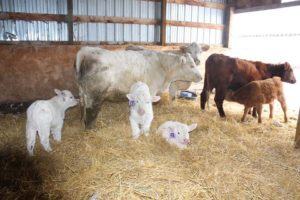Hygiene At Calving/Lambing
13 February 2018 Infections in newborn calves and lambs are likely to be a bigger problem than normal this spring due to the severe shortage of straw. As a consequence, both the use of antibiotics and mortality rates are likely to increase. A programme to maximise calf health and make most efficient use of expensive straw would be –
Infections in newborn calves and lambs are likely to be a bigger problem than normal this spring due to the severe shortage of straw. As a consequence, both the use of antibiotics and mortality rates are likely to increase. A programme to maximise calf health and make most efficient use of expensive straw would be –
- Minimise calving difficulties. This will include ensuring cows are in the right condition (although in general cows are slightly leaner than normal this year). In addition feeding an additional 30 g per day of a high magnesium mineral and 0.5 kg of soya beanmeal, beginning 2 – 3 weeks before calving is due to start, should promote an easier birth and, possibly, more, better quality colostrum.
- Dozy calves. Calves born following a difficult calving and/or have not stood up within 15 minutes of birth, consider giving them an intravenous injection of sodium bicarbonate. Discuss this with your vet and, if he agrees, ask him to train you in the injection technique.
- The objective must be to get as much colostrum as possible into the calf, in its first day of life.
- If calves are slow to suckle either from the cow or the bottle, squirt 20 cc of an rehydration solution around its mouth to help trigger the suckling reflex.
- Dip/spray navel. Wet dirty bedding is likely to increase the incidence of joint ill. If joint ill has been a problem in the past discuss with your vet a procedure for spraying/dipping the navel with iodine. However do not try and dip navels if you have any concerns at all about the docility of the cow.
- Regrouping cows. Providing all is well, cows and calves should be left alone for the first 24 hours. After 24 hours they can be moved into a group of calved cows so rations can be increased and calves have access to a refuge. Cows should be grouped based on the age of their calf with a target maximum range of 10 days. An exception would be first calved heifers who should be grouped together so they can be fed extra for their own body growth.
- A calf refuge. Calves should have access to a refuge, ie a creep without troughs, water, etc. This can be simply achieved by hanging an electric fence wire off the roof, approximately 3 feet above ground level to fence off a narrow strip along one side of the pen. This can then be kept very well bedded which will take relatively little straw as the cows will be kept out.
- If a disease occurs, isolate the cow and calf immediately to minimise any build up of infection. Do not use calving pens as isolation facilities unless calving has completely finished.
- Turn cows and calves out ASAP.
Basil Lowman, basil.lowman@sac.co.uk
Sign up to the FAS newsletter
Receive updates on news, events and publications from Scotland’s Farm Advisory Service
